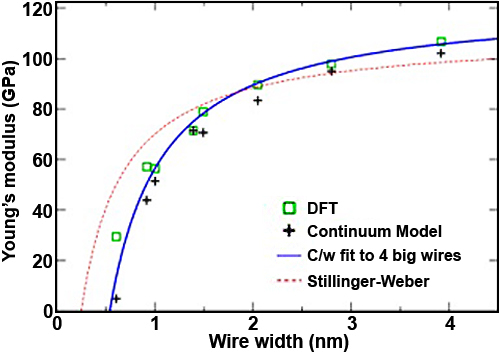Robert E. Rudd, Meijie Tang, Byeongchan Lee, George Gilmer
Collaborators: Miles Blencowe and Meifang Chu (Dartmouth)
Projects: NEMS, Biological Membranes and Cell AFM
Nanomechanics is the science of mechanical behavior at the nanoscale, especially the phenomenon of unexpected and even pathological behavior compared to our understanding of the mechanics of macroscopic systems. Novel behavior is being discovered in many systems of current interest. A classic example discovered by Broughton and coworkers is the scale dependence of the Young's modulus of a beam (a related recent result is shown below).
The Young's modulus is the ratio of the stress to the strain as a beam is stretched, and conventional mechanics asserts that it should be a material constant, independent of scale. At the nanoscale the surface area to volume ratio becomes large, and surfaces make a scale dependent contribution to the Young's modulus so it is not constant. This has implications for nanoscale Micro-Electro-Mechanical Systems (MEMS). As well as MEMS systems, nanomechanics is important in quantum dot systems where the interplay of bulk and surface elasticity leads to surface roughening and island formation, in advanced structural materials where sub-micron grains lead to strong, ductile materials but there are nanoscale limits to the extent the grain refinement is beneficial, and even in biological systems where nanomechanics plays a role in DNA packing and membrane dynamics. There are many other examples, and new ones are continuing to be found as new fabrication and characterization techniques allow more thorough investigation of nanoscale systems. The research we are conducting is a theoretical/computational study of nanomechanics. Its goal is to identify ways in which mechanics at the nanoscale differs from the conventional mechanics operative at larger scales. In the process new techniques, such as Concurrent Multiscale Modeling, are being developed and applied to a range of systems.
Selected Publications
- B. Lee and R. E. Rudd, "Size-dependent Si nanowire mechanics are invariant to changes in the surface state," Phys. Rev. B 84, 161303(R) (2011).
- R. E. Rudd and B. Lee "Mechanics of silicon nanowires: Size-dependent elasticity from first principles," Mol. Sim 34 1 (2008).
- B. Lee and R. E. Rudd, "First-principles study of the Young's modulus of Si <001> nanowires," Physical Review B 75, 041305(R) (2007).
- B. Lee and R. E. Rudd, "First-principles calculation of mechanical properties of Si <001> nanowires and comparison to nanomechanical theory," Physical Review B 75, 195328 (2007).
- R.E. Rudd, G.A.D. Briggs, A.P. Sutton, G. Medieros-Ribiero and R.S. Williams, "Equilibrium Distributions and the Nanostructure Diagram for Epitaxial Quantum Dots," J. Comput. Theor. Nanosci. 4, 335-347 (2007).
- M. Tang, W. Cai, G. Xu, and V. V. Bulatov, "A hybrid method for computing forces on curved dislocations intersecting free surfaces in three-dimensional dislocation dynamics," Model. Simul. Mater. Sci. Eng. 14, 1139 (2006).
- R.E. Rudd, "Coarse-grained molecular dynamics for computer modeling of nanomechanical systems," Intl. J. on Multiscale Comput. Engin. 2, 203-220 (2004).
- R.E. Rudd and J.Q. Broughton, "Concurrent Coupling of Length Scales in Solid State Systems," Phys. Stat. Sol. (b) 217, 251 (2000).
- R.E. Rudd and J.Q. Broughton, "Atomistic Simulation of MEMS Resonators through the Coupling of Length Scales," J. Modeling and Simulation of Microsystems 1, 29 (1999).
- R.E. Rudd, G.A.D. Briggs, A.P. Sutton, G. Medieros-Ribiero and R.S. Williams, "Equilibrium model of bimodal distributions of epitaxial island growth," Phys. Rev. Lett. 90, 146101 (2003).
- C. Adelmann, B. Daudin, R. A. Oliver, G. A. D. Briggs and R. E. Rudd, "Nucleation and growth of GaN/AlN quantum dots," Phys. Rev. B 70, 125427 (2004).





